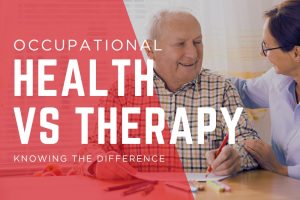Occupational health and occupational therapy. Are they not the same thing? When organisations are looking for health services, they may stumble over these two terms. While they may sound similar, they are very different. If you’ve ever found yourself a little unclear on the difference between the two, you’re not alone, so let’s take a closer look.
What is occupational health?
Occupational health is about preventing and monitoring illness within a workplace setting. It’s a medical-led discipline focused on how work affects health, and how health affects work. Occupational health professionals, such as physicians, nurses and advisors, carry out health surveillance, risk assessments and medical evaluations to ensure employees are fit to carry out their roles safely and effectively. They advise on everything from absences and employee wellbeing, to chronic conditions and statutory medicals.
What is occupational therapy?
Occupational therapy, on the other hand, is not about the workplace per se, but about the person’s ability to work. Occupational therapists are healthcare professionals trained to help people overcome physical, cognitive or emotional challenges that affect their ability to perform daily tasks. These challenges can be work-related, but usually stem from life-changing events such as injuries, illnesses or mental health conditions. In essence, occupational therapy is about enabling participation in meaningful activity, with work being just one part of that wider picture.
How do these disciplines shape the workplace?
In a best-case scenario, occupational health and occupational therapy don’t just co-exist, they complement one another. Occupational health focuses on the systems: ensuring compliance, identifying risks and creating policies that protect workers at scale. Occupational therapy focuses on the individual: understanding the unique barriers a person may face and tailoring interventions to help them function better.
Take for example, an employee struggling with long COVID symptoms. Occupational health might oversee their return-to-work plan, monitor progress and recommend workplace adjustments, whereas an occupational therapist could provide hands-on support with pacing strategies, ergonomic tools and mental health techniques to manage brain fog and fatigue.
What to look for in a provider
Choosing the right occupational health or therapy service can be overwhelming, especially with so many providers claiming to “boost wellbeing” or “reduce absences.” But the real value lies in depth, experience and integration. For occupational health, look for a provider that offers end-to-end support. Credibility matters: are they SEQOHS accredited? Do they have multidisciplinary teams that understand your industry?
For occupational therapy, qualifications are key. Therapists should be HCPC-registered and ideally have experience in vocational rehabilitation or workplace assessments. Just as importantly, they should collaborate with your HR team and medical advisors to create joined-up solutions. And ask questions. Can they demonstrate measurable outcomes? Do they take time to understand your business and your people? Are they proactive rather than reactive?
What’s the takeaway?
While occupational health and occupational therapy share common goals, they take different paths to get there. Understanding this distinction helps you provide employees with the right help at the right time. At MOHS Workplace Health, we believe that healthier workplaces don’t just happen, they’re built through the right partnerships and the right expertise. To learn about how you can protect the health of your workforce, contact us today at info@mohs.co.uk or call on 0121 601 4041.


